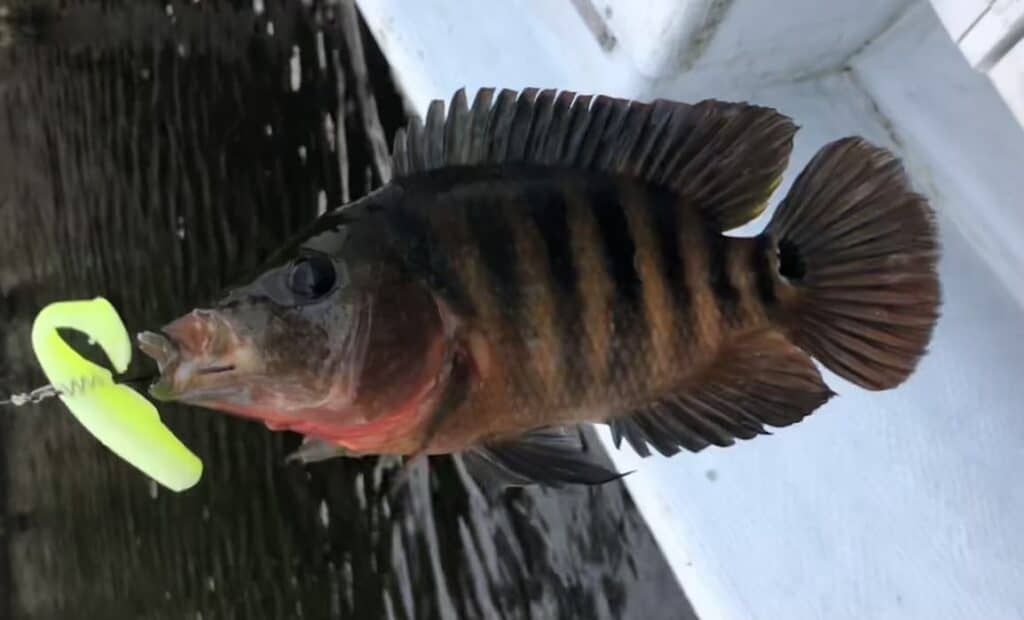
If you’re looking to spice up your fishing adventure, consider learning how to catch Mayan Cichlids. These exotic fish are not only beautiful, but they are delicious to eat and put up a great fight on ultralight tackle or fly fishing gear.
Table of Contents
How To Catch Mayan Cichlids
To catch Mayan Cichlids use small natural baits such as worms, grass shrimp or crickets on a #4 wire hook. Fish near woodpiles, bridge pilings or culverts. Popular artificial lures include the Beetle Spin or small swimbaits.
Mayan Cichlid Diet
The normal diet of Mayan Cichlids includes small fishes and aquatic invertebrates such as snails, insect larvae, worms, and small baitfish. Some Mayan Cichlids have been known to ingest algae and plant matter.
Mayan Cichlid Baits
Since you probably won’t be using snails or mosquitoes while fishing, reliable baits to catch Mayan cichlids include live worms, grass shrimp, and crickets.
Mayan Cichlid Lures
If you prefer artificial lures, try some of the top Bluegill lures on the market. These include Rapala stick baits, beetle spins, crappie jigs, and rubber tube lures as well as wooly worms, popping bugs, and small streamers if you prefer to fly fish.
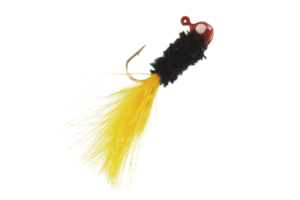
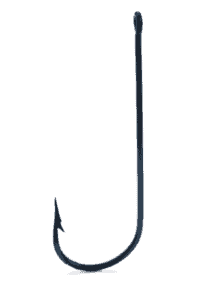

Mayan Cichlid Spawn time and Best Time to Fish
Mayan Cichlids spawn once a year, with peak spawn occurring from May until June. Once their nests are constructed in early Spring, the Mayan Cichlid will guard its nest until its young are hatched and sufficiently viable.
The best time to fish for Mayan Cichlids is during the late spring and early summer months of May, June and July.
Mayan Cichlid Fishing Tips & Tactics
In order to catch Mayan Cichlids and add them to your species list, you need to be sure you are fishing in the correct habitat. They prefer shallow, clear water around 2 meters, or 6 feet deep.
In the United States, the Mayan Cichlid is found in the wild in southern Florida and isolated parts of south Texas.
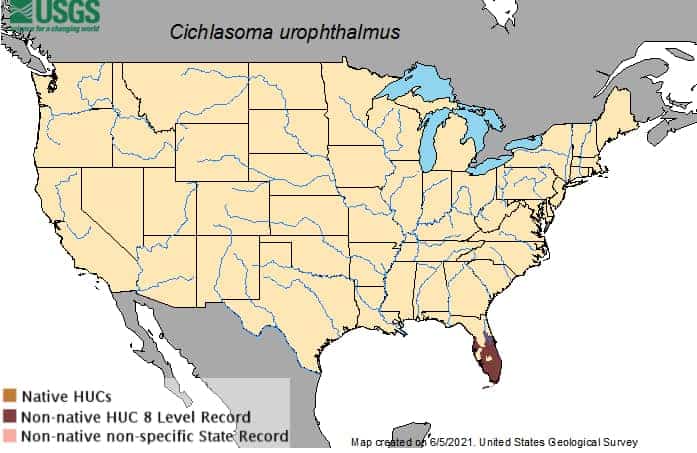
Mayan Cichlids prefer rivers, lakes, ponds, marshes and can even tolerate brackish estuaries. In south Florida in particular, Mayan Cichlid is very popular and common in the miles of canals in urban cities such as Miami, Ft. Lauderdale & West Palm Beach.
Try ‘chumming’ the waters with bread, crackers, or small pieces of hot dog or dead minnows. Mayan Cichlids are voracious predators and this can help you locate fish (with polarized glasses) before you begin fishing.
About The Mayan Cichlid
The Mayan cichlid or Cichlasoma Urophthalmus is a medium-sized fish similar to other sunfish species. Common names include the mexican mojarra, orange tiger and castaricca in Spanish.
Mayan Cichlid Habitat
Mayan Cichlids exist in a wide range of habitats. Being euryhaline fish, they can tolerate a wide range of salinity, or salt, levels. Typically, Mayan cichlids prefer coastal lowland habitats and can be found teaming in residential canals, ponds, ditches, lakes and creeks.
Mayan Cichlid Distribution
The native range of the Mayan Cichlid are the waters of tropical central America in the Caribbean sea extending from the southern Yucatan peninsula to Nicaragua. Mayan Cichlids were first spotted in Florida in 1983, with their range now extending from the Keys and the everglades up to the Big Cypress Swamp, Lake Okeechobee and parts of Central Florida.
Mayan Cichlid Size and Identification
Mayan Cichlids are considered to have a classic, tear-dropped “panfish” shape, as opposed to longer and leaner fish like barracuda or salmon or more rotund fish like tuna.
Mayan cichlids average 70-130 mm (2.5-5 inches) in length after 1 year of age while two-year-old fish average roughly 130-200 mm in length. Males are usually slightly larger than females.
They possess spiny dorsal and anal fins with smaller pectoral and pelvic fins. The mouth is even proportioned with the body, with their coloring being the most distinct feature.
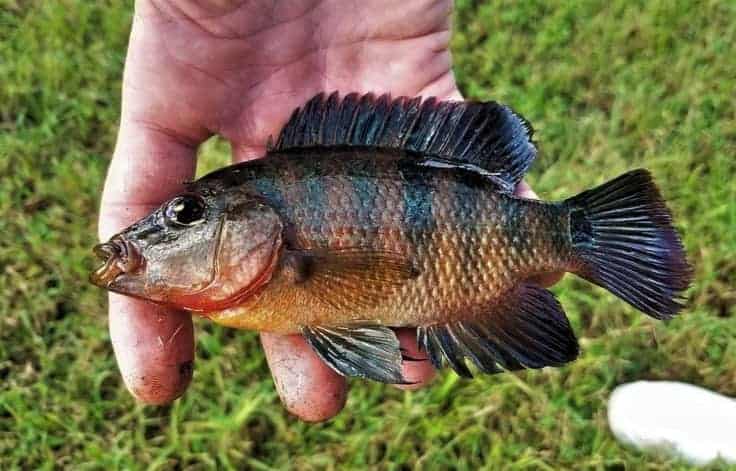
Adult Mayan cichlids feature an olive-brown background that can incorporate pink on the edges of its scales and fins and which transitions to beige around the abdomen.
There are 5-7 vertically aligned, green-black “bars” that run vertically along the dorsal side. The primary distinctive feature of the Mayan cichlid is a silver-blue eyespot on its tail that aids in distracting and deterring predators.
Differences between juveniles and adults
Aside from increasing in size, the main differences between juvenile and adult Mayan cichlids are the large yellow eyes found in juveniles and a darkening and increased coloring of scales in adults.
Ecology and relation to other fish species
There is uncertainty regarding the exact route of introduction of Mayan Cichlids to Florida’s waters, as the fish may have been introduced and spread through released aquarium fish, escaped fish from fish farms or from amateur anglers.
Mayan Cichlids are now considered invasive species because of their potential impacts to native fish feeding and breeding habits, such as largemouth bass, warmouth, and spotted sunfish.
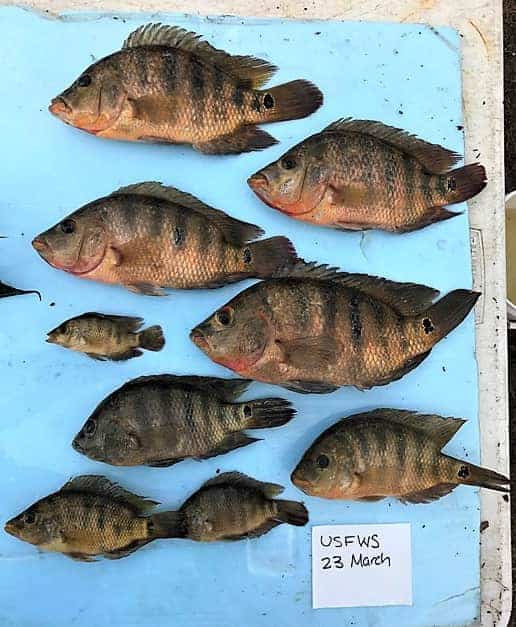
Given its ability to live in a wide range of habitats, Mayan cichlids can potentially compete with native fish for food and breeding grounds while also predating on smaller fish species and potentially introducing disease.
The greater risk is the highly aggressive behavior of males during mating season which can lead to potential injuries or death from native fish that encroach within contested breeding grounds. This behavior is of greatest concern in the mangroves along the Florida coastline where Mayan Cichlids have increased substantially.
Eating Mayan Cichlid
Although Mayan Cichlids are not the most ecologically friendly fish, they are considered to be excellent eating fish for their moist, white, flaky flesh.
Before you cook your fish, it’s always a good idea to descale and remove the innards. Descaling can be done with a spoon or a knife rubbed briskly in the opposite direction the scales extend, rotating the fish as you go to ensure that all the scales are removed.
Cleaning the fish can be done by inserting a knife about an inch from the anal pore in the abdominal side of the tail and slicing upwards. Reach in and pull everything out so you don’t eat the kidneys or gallbladder which will be noticeably bitter.
Mayan Cichlid Recipe
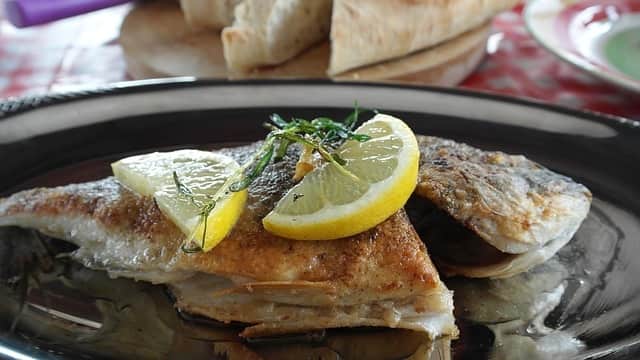
There is an abundance of ways to enjoy your Mayan cichlid, and given their non-native status multiple meals a week may be considered a public service. If you’re looking for a quick and simple recipe that captures the South American flavor associated with its native habitat, try the following:
Ingredients:
- 1-2 scaled and gutted Mayan Cichlid (whole)
- cooking oil
- 1 garlic clove
- 1/2 lemon
- 1 tbsp salt
- 1 tsp pepper
- 1/2 cup all purpose flour
Instructions:
In a pan large enough to cover the fish in oil, heat 1 liter of oil over medium heat.
Rinse and dry the fish, making several diagonal ‘score’ cuts along its side. Season the fish with salt and pepper, then coat with flour. Add a few garlic cloves and lemon peel to the oil.
Once the oil is hot, place the fish in the oil, cooking for approximately 4-6 minutes until skin and flour is golden brown. Flip the fish over, and cook for an additional 2-3 minutes.
Remove the fish and let rest up on a paper towel for 2 minutes. Garnish with fresh lemon, tartar sauce or ketchup. Voila! The meat should easily peel away from the bones with a fork.
FAQ
Below are some frequent questions asked in relation to the Mayan Cichlid.
Are Mayan Cichlids invasive?
Given their original habitat and means of introduction, the Mayan cichlids are definitely classified as non-native fish. That being said, invasiveness depends on whether the species harms other organisms or the habitat in which it was introduced. In some areas of Florida, the Mayan cichlid is considered more invasive than others.
Are there regulations or fishing limits for the Mayan Cichlid?
If you like catching as many fish as possible, then the Mayan Cichlid is for you. Given their non-native status and their abundant population, there are no fishing limits or regulations for this fish.
What is the world record for the Mayan cichlid?
The world Mayan Cichlid is 2.5 pounds and 12.6 inches in length.
Do Mayan Cichlids have teeth?
Given their predatory nature, Mayan cichlids have small, caniform teeth that allow them to grasp prey. However, most of their chewing is done through tooth pads located at the back of their throats.
Are there different types of cichlids?
Cichlidae, the taxonomical family that Mayan Cichlids belong to, contains roughly between 1,000 and 2,000 species, making it one of the largest taxonomical freshwater fish families in the world.
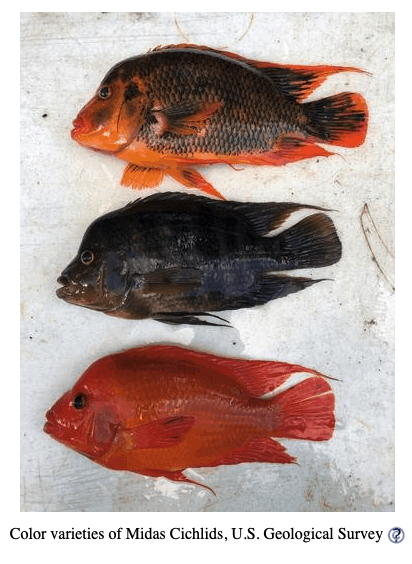
There are many types of cichlids present in the United States such as the African Cichlid, Midas Cichlid, Jaguar Guapote and Black Acara. Each of these contributes to a very popular invasive fish industry.
Can you buy cichlids to introduce?
You can buy Mayan cichlids but, given that they are a non-native species, it is neither advised nor recommended that you introduce them to any wild habitats given their ability to adapt and reproduce readily. In many states, it is illegal to introduce non-native fish to local waterways.
Conclusion
Hopefully, you’ve learned a little about the Mayan Cichlid and how to catch this invasive yet abundant fish.
Like this post? Save it on Pinterest.
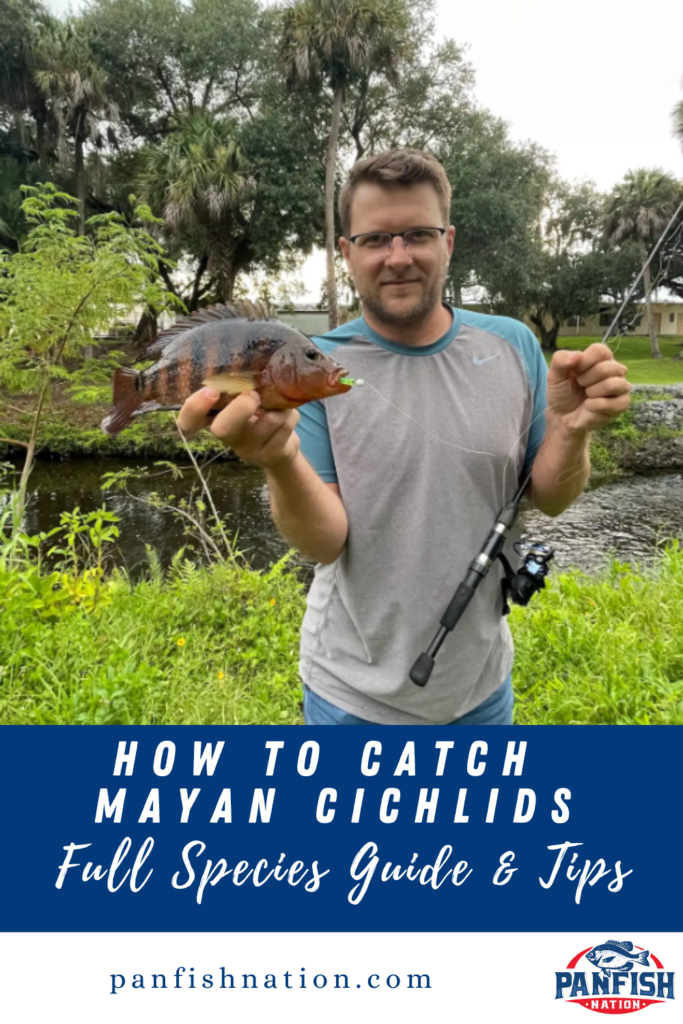
If you haven’t guessed yet, I love fishing and everything about it!
To learn more about why I started Panfish Nation, visit the About page and follow along on Social Media:


Download a copy of my FREE Lure Color Selection Chart & Knot Guide!
Stay up to date with fishing reports, tackle reviews, industry news, and much more! We respect your privacy, unsubscribe at any time.
Additional Reading
- Sauger vs Walleye: Learn These Differences and Catch More!
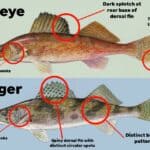
- How To Hold A Bluegill: Tips and Best Practices
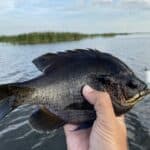
- How To Catch Wild Shiners For Bait (Step By Step W/Pics)
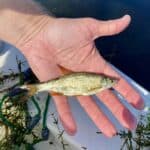
- Crazy Facts About the World Record Crappie

- What Size Hooks for Smallmouth Bass? Quick Guide

- Large and in Charge-Mouth: 10 of the Best Bass Lures of All Time (And Where to Buy Them)

